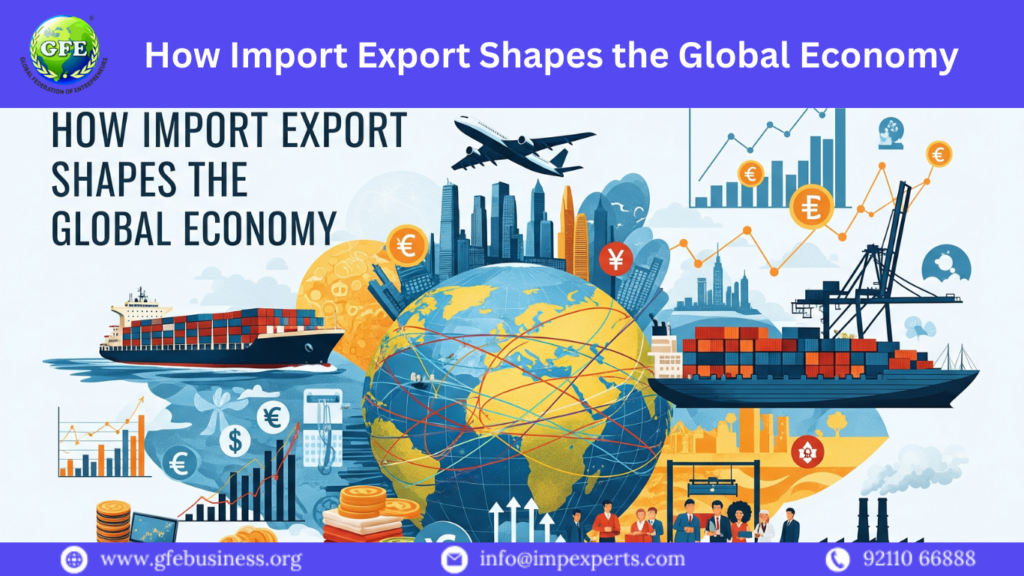
How Import Export Shapes the Global Economy
Import Export has always been at the heart of global trade, fueling innovation, job creation, and international cooperation. Whether you are a business owner, entrepreneur, or student considering a career in international trade, understanding how import export shapes the global economy is crucial. At GFE Business, we help businesses set up and expand their import export operations with professional support and training.
What is Import Export and Why Does It Matter?
Import Export refers to the exchange of goods and services across international borders. Import means bringing products into a country, while export means sending products abroad. Together, they form the backbone of globalization.
According to the World Trade Organization (WTO), over 60% of the world’s GDP is linked directly to global trade. This demonstrates how deeply import export influences economic growth, innovation, and employment.
The Role of Import Export in Economic Growth
1. Boosting National Economies
Import Export activities contribute significantly to a nation’s GDP. Countries like China, the United States, and Germany thrive as leading exporters, while developing countries benefit by importing technology and raw materials.
2. Creating Employment
Every shipment requires logistics, warehousing, customs clearance, and distribution. As a result, import export supports millions of jobs globally.
3. Encouraging Innovation
Competition from foreign goods pushes domestic businesses to innovate and improve their quality.
Why Entrepreneurs Should Consider Import Export
Starting an import export business provides multiple advantages:
Access to a global customer base.
Opportunities to work with diverse products and markets.
Potential for high profit margins compared to domestic trade.
If you’re planning to step into this field, enrolling in an import export training program from institutes like GFE Business can prepare you with the right knowledge.
Import Export and Global Supply Chains
Supply chains depend on import export to keep goods flowing across borders. For example:
Electronics: Components made in Japan, assembled in China, and sold in India.
Food: Coffee from Brazil, cocoa from Ghana, and rice from India reach global markets through import export.
Without this system, global commerce would collapse.
Challenges in Import Export
While lucrative, the industry faces challenges such as:
1. Trade Barriers
Tariffs, quotas, and government restrictions impact trade.
2. Currency Fluctuations
Exchange rates can affect profits in import export businesses.
3. Logistics & Compliance
International shipping and customs documentation must be precise to avoid penalties.
Future of Import Export: Trends to Watch in 2025 and Beyond
The future of import export looks promising with:
Digital Trade Platforms (Amazon Global, Alibaba).
Blockchain in Supply Chains ensuring transparency.
Sustainable Trade with eco-friendly logistics.
According to UNCTAD, e-commerce in trade is expected to grow by 20% annually, making import export more accessible to small businesses.
How Governments Support Import Export
Governments across the world encourage trade by:
Providing subsidies and incentives.
Establishing Export Promotion Councils (EPCs).
Creating bilateral trade agreements.
India, for example, offers the Foreign Trade Policy (FTP) to guide exporters and importers. More details can be found on Invest India.
How to Start an Import Export Business
If you’re planning your first steps:
Research Your Market
Identify demand for specific products internationally.Get the Necessary Licenses
Apply for IEC (Import Export Code) in India.Build Supplier and Buyer Networks
Platforms like Alibaba, TradeIndia, and GFE Business can help.Understand Compliance & Documentation
From invoices to bills of lading, proper documentation is key.Partner with Experts
Agencies like GFE Business provide consultancy for setting up businesses, documentation, and training.
Case Studies: Import Export in Action
India’s Pharma Exports: India exports pharmaceuticals worth over $24 billion annually, supplying critical medicines worldwide.
Middle East Oil Exports: Oil exports from the Middle East keep energy flowing across the globe.
European Luxury Goods: Fashion exports from Italy and France dominate international markets.
These examples prove how import export drives the global economy.
Internal and External Links
Internal: GFE Business – Import Export Business Setup & Training.
External: WTO, UNCTAD, Invest India.
Suggested Image:
A world map with cargo ships, airplanes, and containers representing global trade.
Alt Text: Import Export shaping the global economy
Conclusion
Import Export is more than just moving goods across borders—it is the foundation of global economic progress. By understanding its role, entrepreneurs can tap into massive opportunities, build global networks, and achieve sustainable growth.
Whether you are a beginner or experienced trader, working with experts like GFE Business can simplify compliance, reduce risks, and maximize profits. In 2025 and beyond, import export will continue to shape how nations and businesses grow together in a connected world.